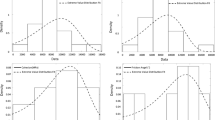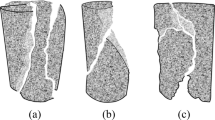Abstract
Rock quality designation (RQD) parameter distributions are obtained by Monte Carlo simulation techniques to describe the excellent, good, fair, poor and very poor rock percentages within a given rock mass. In the simulations, the intact length distributions are chosen either as the negative exponential or logarithmic-normal distribution.
Rock quality designation is dependent on a predetermined level of truncation and therefore the simulation procedure is repeated for different levels and their effects are presented in various charts.
RQD distributions are given in detail for different average number of discontinuities. The logarithmic normal distribution is unique in the sense that it preserves in the simulation the variance of intact lengths independently from the mean value. The greater the variance the better is the rock quality.
Résumé
La distribution des valeurs de RQD (Rock Quality Designation) obtenues par les techniques de simulation de Monte Carlo est utlisée pour décrire les pourcentages de roche de qualité excellente, bonne, moyenne, faible ou très faible dans un massif rocheux donné. Dans les simulations, la loi de distribution des longueurs est choisie soit comme une exponentielle négative soit comme une loi de log normal.
Le R. Q. D. dépend d'une longuer prédéterminée de coupure et en conséquence la procédure de simulation est répétée pour différents niveaux et les résultats sont présentés sur différentes abaques.
Les distributions du RQD sont données de façon détaillée pour différents nombres moyens de discontinuités. La distribution logarithmique normale est intéressante car dans la simulation la variance des longueurs apparaît indépendante de la valeur moyenne. Plus la variance est élevée, meilleure est la qualité de la roche.
Similar content being viewed by others
References
BARTON N., LIEN F. and LUNDE J., 1974. Engineering classification of rock masses for the design of tunnel support. Rock Mechanics, vol. 6, No. 4, pp. 189–236.
BIENIAWSKI Z.T. 1974. Geomechanic classification of rock masses and its application in tunneling. Int. Soc. Rock Mech., 3rd, Denver, Colorado, September 1974, Proceedings, Vol. 2A, pp. 27–32.
COATES D.F., 1964. Classification of rocks for rock mechanics. Int. Jour. Rock Mech. Min. Sci. & Geomech. Abst., Vol. 1, No. 3, pp. 421–429.
DEERE, D.U., 1963. Technical description of rock cores for engineering purposes. Rock Mech. and Enging. Geology, Vol. 7, No. 7, pp. 16–22.
DEERE D.U., 1968. Geologic considerations. In Stagg K.G. and Zienkiewicz O.C. (editors). Rock Mechanics in Engineering Practice, John Wiley and Sons, New York, NY, pp. 4–20.
EGE J.R., 1987. Core index. A numerical core-logging procedure for estimating rock quality. U.S. Geol. Surv. vol. 954, vol. 954, pp. 1–15.
GOODMAN R.E., 1976. Methods of Geological Engineering. St Paul, West publishing Company, 472 p.
HAMMERSELY J. M. and HANDSCOMB D.C., 1964. Monte Carlo Methods., Methuen and Co. Ltd. 178 pp.
PRIEST S.D. and HUDSON J.A., 1976. Discontinuity spacings in reck. Int. Jour. Rock Mech. Min. Sci. & Geomech. Abst., Vol. 13, No. 5, pp. 135–148.
SEN Z., 1984. RQD models and fracture spacing. J. Geotech. Engng., Amer. Soc. Civ. Engng., Vol. 110, No. 2, pp. 203–216.
SEN Z., 1990. RQD, RQR and fracture spacing. Technical Note. Int. Jour. Mech. Min. & Geomech. Abst., (in print).
SEN Z. and KAZI A., 1984. Discontinuity spacing and RQD estimates from finite length scanlines. Int. Jour. Rock Mech. Min. Sci. & Geomech. Abs. Vol. 21, No. 4, pp. 203–212.
TERZAGHI K.C., 1946. Introduction to tunnel geology: Rock defects and loads on tunnel supports. In Protor, R.V., and White, T.L., Rock tunnelling with steel supports: The commercial shearing and stamping co., Youngs town, Ohio, pp. 15–99.
Author information
Authors and Affiliations
Rights and permissions
About this article
Cite this article
Eissa Elsayed, A., Sen, Z. Probabilistic simulation of rock quality designation (RQD). Bulletin of the International Association of Engineering Geology 43, 31–40 (1991). https://doi.org/10.1007/BF02590168
Issue Date:
DOI: https://doi.org/10.1007/BF02590168




